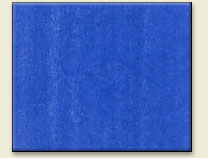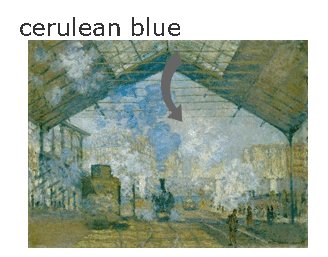
Brief description of Cerulean blue:
It's a cobalt stannate which was introduce as a pigment in the 1860s. Very stable and lightfast greenish blue with limited hiding power. Cerulean blue has a fairly true blue (not greenish or purplish) but it doesn't have the opacity or richness of cobalt blue. It was not recommended for use in watercolor painting because of chalkiness in washes. In oil, it was particularly valuable to landscape painters for skies.
Names for Cerulean blue:
| Alternative names: | cobaltous stannate | ||||||
| Word origin: | The name "Cerulean blue" comes from Latin caeruleus = dark blue caelum which in turn probably derives from caelulum, diminutive of caelum, "heaven, sky".. | ||||||
| Non-English names: |
|
||||||
| Origin: | artificial | ||||||
| Chemical name: | Cobalt(II)-stannate |
Example of use by artists:
Impressionists' skies comes from cerulean blue

Claude Monet's La Gare Saint-Lazare, 1877, Musee d'Orsay Paris.
Armed with this new battery of brilliant colours, the Impressionists set their canvases
alight with fireworks, leading the conservative Vibert to denounce them as ‘dazzlers’
(éclatistes) who painted ‘only with intense colours’. Pissarro claimed to have banished
the old, dull ‘earth’ colours from his palette, and Monet constructed his ochres and khakis
from complex mixtures of the new, bright pigments. Even the gloom of Monet’s La Gare
Saint-Lazare (1877) is a concoction of rainbow hues: cobalt blue, cerulean blue, synthetic
ultramarine, emerald green and viridian.
(intro) - Azurite - Cerulean Blue - Cobalt blue - Egyptian blue - Prussian blue - Smalt - Ultramarine

